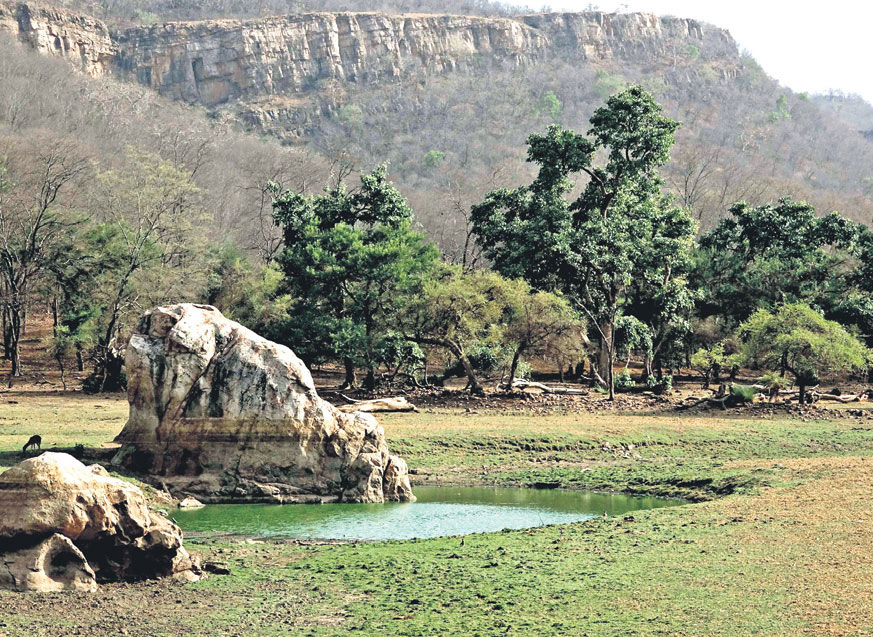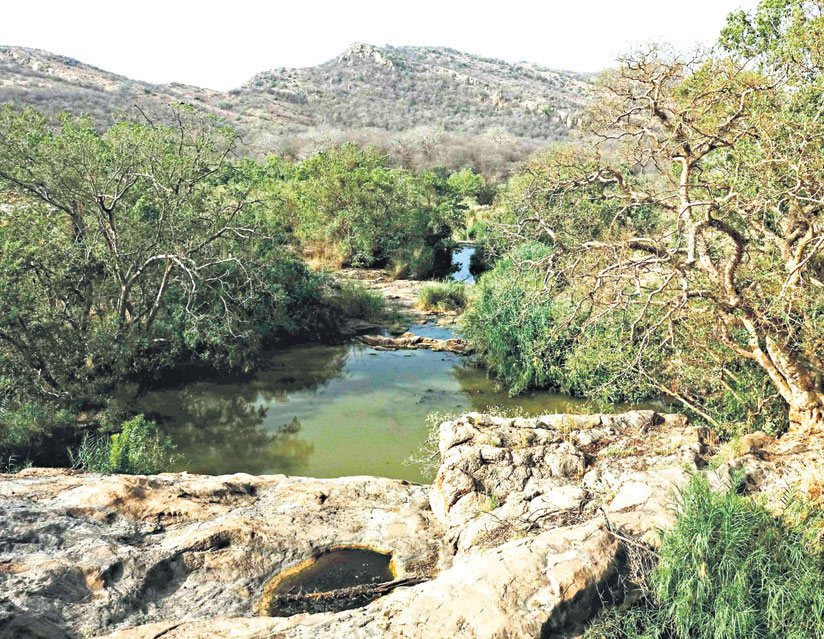Rewind: Tiger, Tiger burning bright …in Ranthambore
Tracking and tackling the big cat in its kingdom on undulating topography is often a game of immense patience

By N Shiva Kumar
Tracking the tiger in the wild timberland is a tantalising task and with tenacity to see the big cat in the jungles, we set out for an adrenaline-rush adventure to the Ranthambore Tiger Reserve (RTR). The scorching tropical Indian summer heat was hovering at 44 degrees celsius as if the forest was on fire.
Tigers, however, are terrific in their tactical demeanour as they are in total control of their temperament despite high temperatures. To beat the intense heatwave, they seek solace by either going to slumber in shady, secure and secluded forest patches or plonk in placid pools waiting for nightfall to negotiate the terrain in their territory. Serious wildlife enthusiasts prefer summer safaris as it is comparatively easier to locate a tiger as they tend to wander close to water bodies to calm their heated bodies. As forest foliage, including ground vegetation, dwindles to the bare minimum, it is making tiger detection easier than usual. Ranthambore is also reckoned the driest tiger habitat in the world and this makes spotting tigers easier in its natural habitat compared to other tiger reserves in India.
Ranthambore is also reckoned the driest tiger habitat in the world and this increases spotting tigers easier in its natural habitat compared to other tiger reserves in India
Tracking and tackling a tiger in its kingdom on undulating topography is often a game of immense patience. Sometimes you are just lucky to sight a tiger or a tigress approaching straight at you and at other times, there is no clue whatsoever even after driving 20-30 km in the dusty tracts of jungle. At times, we tend to run into a big cat surrounded by eager and unruly tourists creating commotion in the silence of the forest. The hotness and dust in summer and chilling weather in winter add to the challenge of chasing hidden tigers in the RTR. Regular tourists treat a tiger with curiosity, while first-timers are scared at the thought of seeing a wild tiger from an open vehicle. Tiger watching is like an addiction and it’s even more pleasurable if a tiger mother is with cubs or grownup siblings playing pranks with mock fights or jostling in the lake waters.

Machali, Sundari, Sultan, Ustad, Noor, Arrowhead, Riddhi and Siddhi are some of the famous and popular tigers of Ranthambore, known more with their names than the official numbers allotted to them like T-17, T-27 and T-30. Every tiger has facial markings that are unique like our fingerprints, making identification of the big cat easier. While female tigers have their own territories and generally don’t tend to trespass, male tigers have larger territorial rights to cater with their multiple female partners. Tourists wanting to see tigers are allotted safaris from zones 1 to 10 that are spread across the landscape from east to west and specified three to four hours to explore depending on the seasons.
Situated 150 km south of Jaipur and 400 km south by southwest of New Delhi in arid Rajasthan, Ranthambore is an oasis in the desert. Located at the junction of the geologically oldest mountain ranges with rich flora and fauna, Ranthambore offers splendid opportunities for viewing the magnificent tiger in the wild. Apart from the terrific tigers, one can also spot secretive leopards, extremely rare caracal cats, clumsy sloth bears, lazy crocodiles, jackals, foxes, hyenas, mischievous mongoose, slithery snakes and 350 variety of bird species. The elusive Indian wolf, too, has also been spotted on some occasions, claim forest officials.
Lavish Landscape
The Ranthambore National Park is situated at the confluence, great boundary fault, of the Aravalli and the Vindhya ranges and is flanked to the north by the Banas River and to the east by the Chambal River. The park’s landscape has notable archaeological features like the Ranthambore fort, a world heritage site, and dotted with ruins of medieval temples and edifices. Ranthambore consists of various natural sites with varying conservation histories that are physically isolated by only short pathways connecting them to the centre of the sanctuary.
Ranthambore is part of the central Indian landscape’s western block, which also comprises Sariska Tiger Reserve, Kuno-Palpur Wildlife Sanctuary, Madhav National Park, Ramgarh Vishdhari Wildlife Sanctuary and Mukundara Hills Tiger Reserve. Each of these large jungle junctions was once seamlessly connected with green corridors for tigers to move about and intermingle thereby avoiding inbreeding. Regrettably, these conducive corridors are now tattered with unruly roads being built into the wildernesses creating undue anxiety for wildlife.

Project Tiger was launched in 1973 by former PM Indira Gandhi to contain dwindling population and this originated in real earnest and woodland wealth as Ranthambore regained its original vigour
Once, the royal hunting grounds of Indian maharajas and later of the British, tigers were killed for pleasure at Ranthambore while poachers slaughtered for profit. This stretch of jungle was declared a tiger reserve with the intention of safeguarding the supreme cats that have been vanishing across the Indian subcontinent due to poaching and public encroachments.
The ambitious Project Tiger was launched in 1973 by former Prime Minister Indira Gandhi to contain the dwindling population and this originated in real earnest and woodland wealth in Ranthambhore regained its original vigour. Surprisingly, aquifers in the area began to replenish and water tables increased much to the advantage of the surrounding villagers. Even now, the difference in the ecology inside the Ranthambore Tiger Reserve and outside is staggeringly evident to visitors to the park.
Teething Troubles
The Government of India used to issue hunting permits until 1969, but Indira Gandhi, who ruled the roost, and Kailash Sankhala, former director of the Delhi Zoo, demanded safety for the beleaguered tigers. Fortunately, Fateh Singh Rathore, a passionate forester fostered this forest to its pristine glory by preparing a perfect plan for the protection of jungles. This involved shifting 20 villages from inside the park and convincingly rehabilitating rustic folk by 1976-77 when all the villages were moved out and tigers began to freely move in. In 1980, former Prime Minister, Rajiv Gandhi, who was a regular guest, made the Ranthambore National Park famous as a wildlife destination for tourists wanting to see the tiger. Sometimes, he even operated his Prime Minister’s office work from the historic hunting lodge, Jogi Mahal, next to the lake, in this outstanding sanctuary to get away from the concrete jungles of New Delhi.
The tropical tapestry of jungles in Ranthambore provides enough prey for tigers in the form of dainty spotted deer (Chital), bulky sambar deer, hefty horse-like nilgai (blue-bull) antelope, rhesus macaque, langur monkeys, etc. Even crocodiles, basking in the three lakes of Ranthambore, have been hunted by certain courageous tigers, which is considered rare. Tigers also manage to kill wild boar and wild bears if they get a chance to run them down but their preference for monkey meat is evident. As ample prey animals thrive in the jungles of Ranthambore, tigers are generally healthy and wealthy enough to trigger regular breeding with prolific progeny. I was fortunate to see mating tigers on two different occasions in two different years and they have the energy to mate more than 40 times in a day which is a natural phenomenon.
As ample prey animals thrive in the jungles of Ranthambore, tigers are generally healthy enough to trigger regular breeding with prolific progeny
Currently, the tiger population is estimated to be around 70, however, cubs are not included in the population count, say government officials. Tigers in general give birth to a litter of two to four of which one or two tend to survive to adulthood, on occasions all four survive if the mother is an experienced and shrewd hunter.
Because the survival rate is high, Ranthambore has become a natural breeding hub for tigers. The increase in numbers is one of the reasons that tigers seem to spill over from designated boundaries of the reserve. Bountiful breeding has helped select young adults to be shifted, literally airlifted, to nearby wildlife sanctuaries where tigers have disappeared due to poaching or poisoning. As in the case of Sariska National Park, which is about 170 km north of Ranthambore, tigers were reintroduced and are prospering with offspring.
Booming Business
The Ranthambore Tiger Reserve, sprawling over 1,700 sq km, is one of the greatest success stories of wildlife conservation in the world. Tigers are mostly loners and designed to dominate, however they come together to mate and make babies. In recent years, tigers have been treating tourists with interesting encounters and some have become legendary in their demeanour and daily catwalks. Numerous books and documentary films have been written on famous tigers and tigress that thrive in Ranthambore. Correspondingly, a number of budget and luxury hotels has cropped up to cater to the rising tiger tourism.

“Many modern conservation initiatives taken by the 365-strong workforce of the forest department have increased the inflow of Indian and foreign tourists to a staggering 6.5 lakh tourists. This has infused annual returns of Rs 60.35 crore in the last financial year which is way ahead of all other national parks and sanctuaries in India,” says Dr Dharmendra Khandal, an author and conservation biologist with Tiger Watch for the last 21 years. Tiger Watch is an agile and active organisation, founded in 1997 by Fateh Singh Rathore, to combat poaching and is involved in the scientific study of the wildlife in the Ranthambore region.
The Ranthambore Tiger Reserve, celebrates its 50 years, and is spread across 1700 sq km. It is one of the greatest success stories of wildlife conservation in the world
To make your holiday picture perfect with a breath of fresh air, go to see the cool cat and this will elevate you to an enchanting engagement with untamed nature, a curative process for the stressed mind of the city dwellers. When I am blunted by the daily drudgery of the corporate world, you can find me roaming in Ranthambore, indulging in the ingredients where the tigers flourish.

(The author is an independent journalist and documentary wildlife photographer)
Related News
-
Cartoon Today on December 25, 2024
3 hours ago -
Sandhya Theatre stampede case: Allu Arjun questioned for 3 hours by Chikkadpallly police
4 hours ago -
Telangana: TRSMA pitches for 15% school fee hike and Right to Fee Collection Act
4 hours ago -
Former Home Secretary Ajay Kumar Bhalla appointed Manipur Governor, Kerala Governor shifted to Bihar
4 hours ago -
Hyderabad: Organs of 74-year-old man donated as part of Jeevandan
4 hours ago -
Opinion: The China factor in India-Nepal relations
4 hours ago -
Editorial: Modi’s Kuwait outreach
4 hours ago -
Telangana HC suspends orders against KCR and Harish Rao
5 hours ago




